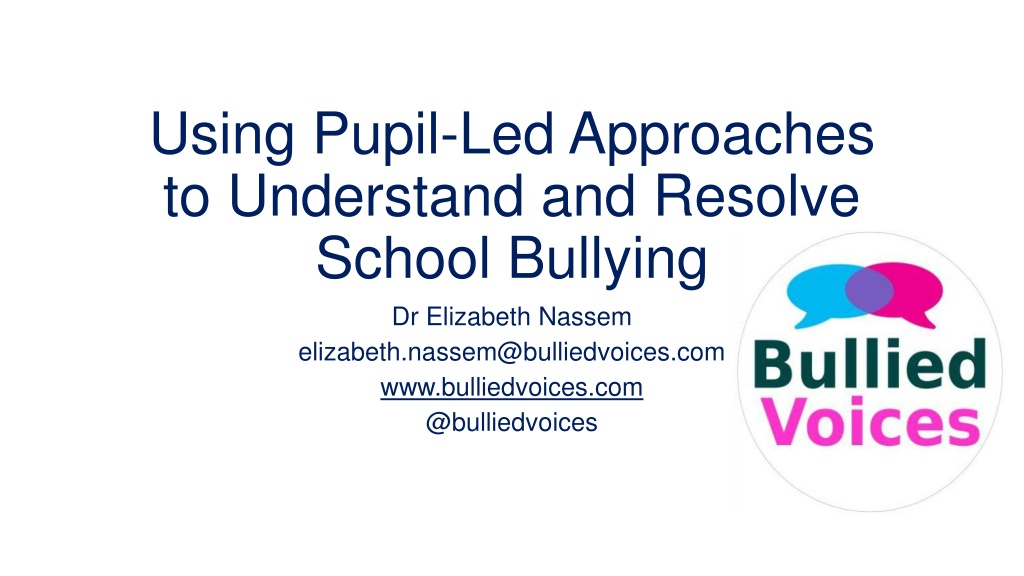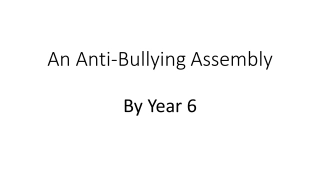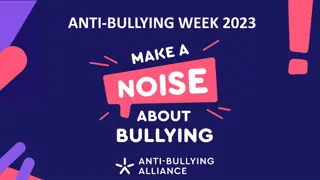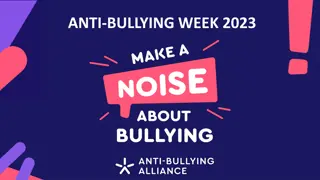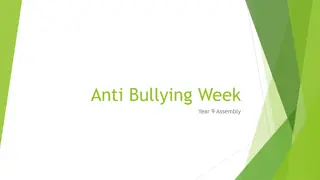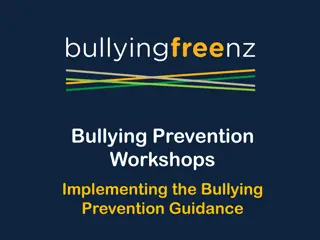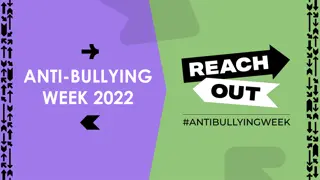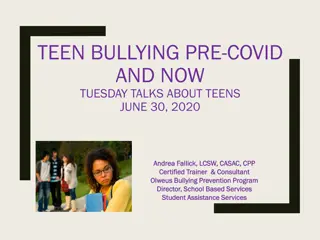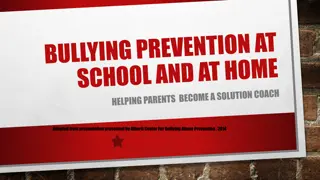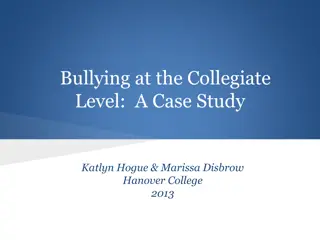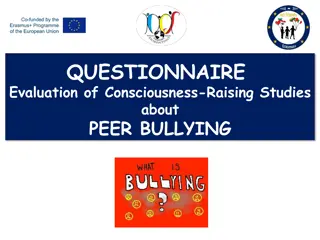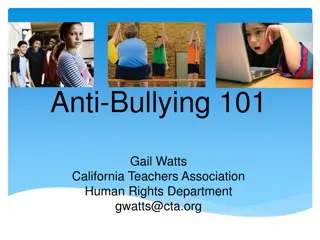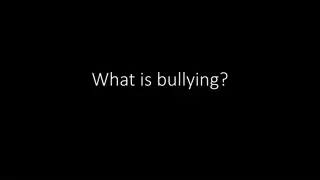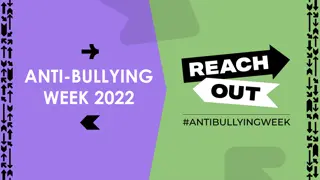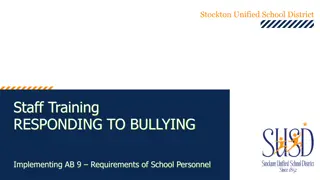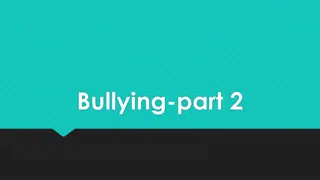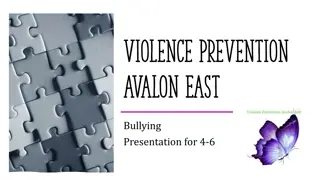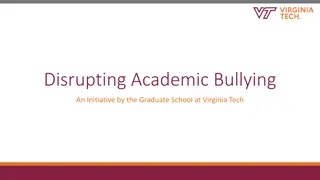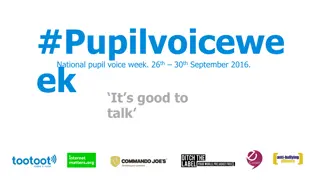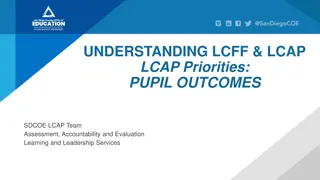Pupil-Led Approaches for Understanding and Resolving School Bullying
Explore how Dr. Elizabeth Nassem's Bullied Voices initiative utilizes pupil-led strategies to tackle school bullying. The approach focuses on understanding individual experiences, involving children directly, and tailoring interventions based on specific needs. By drawing upon the voices of pupils and working collaboratively with staff, this method aims to create a more person-centered and effective approach to combat bullying.
- School Bullying
- Pupil-Led Approaches
- Child Advocacy
- Intervention Strategies
- Anti-Bullying Initiatives
Download Presentation

Please find below an Image/Link to download the presentation.
The content on the website is provided AS IS for your information and personal use only. It may not be sold, licensed, or shared on other websites without obtaining consent from the author. Download presentation by click this link. If you encounter any issues during the download, it is possible that the publisher has removed the file from their server.
E N D
Presentation Transcript
Using Pupil-Led Approaches to Understand and Resolve School Bullying Dr Elizabeth Nassem elizabeth.nassem@bulliedvoices.com www.bulliedvoices.com @bulliedvoices
Introduction to Bullied Voices Evidence-based: Doctoral and post-doctoral research on school bullying (Nassem 2012, Nassem 2019b). Draws upon the voices of pupils to understand and resolve bullying (Nassem 2017). Voices of school staff. Posters, assemblies, slideshows and switching off (Nassem 2019a). Involving children more directly. Worked with all children about their issues with bullying. Tailored strategies to deal with children s specific experiences. No bullies in my research: Focus on being targeted rather than on the harm they may have subjected others to. Responsibility and agency. Understanding the effects of their behaviour or others and the perspectives of others.
Aims of Bullied Voices Understanding bullying and individual experiences. Person-centred and pupil-led. Tailored to individual s specific problems with bullying. Working with pupils and staff to resolve bullying. Academic research and publications. Political. Individualised and strategic support: schools and local authorities. Resolving bullying between pupils, pupils and school staff, bullying amongst staff and systemic bullying (e.g. school systems).
A Pupil-Led Approach Pupils experiences of bullying and pupil-led strategies can be overlooked by local and national policy when interventions designed. Pupils offer a wealth of knowledge and resources to improve policy. A pupil-led approach ensures that children s specific experiences of bullying are understood and addressed. Nuanced cases e.g. friends and arguing: It s not really bullying , if it was bullying we d deal with it (staff).
How does it Work? Interview children about their experiences of bullying. Interview children about how to develop an intervention (e.g. how is bullying dealt with and how should it be dealt with?). Interview staff about pupils experiences of bullying and how to develop an intervention. Individual interviews, focus groups and observations. Meet with staff and pupils to agree intervention and an output.
What Does an Intervention Look Like? An emotional outlet diaries (Nassem 2018): In-depth, complex, profound and surprising. Understanding why children bully to deal with it e.g. popularity. Mentoring for children who bully: Reflecting on specific situations and learning how to interpret and respond to them respectfully. Communication: eye-contact, role-models. Working with pupils in groups to understand and resolve their bullying: e.g. learning what happened discussing and practising how to respond. Understanding perspectives of others: Role-play, pictures, discussions, pausing.
What does an Intervention Look Like? What do they say? How does it make you feel e.g. words, pictures, talk. Considering and practising alternatives. Reviewing school policies on bullying. Mediation after mentoring and group work. Output e.g. pupil-led assembly (Nassem, 2015) - sharing experiences, poems an advice. Meeting with staff and pupils to feedback what have learnt and develop the work with staff.
Notes Change is difficult and progress: thoughts and behaviour. Children felt listened to and that their feelings and experiences were important. This is the best part, where we tell you all our situations and we ll talk (pupil). Connecting their behaviour with others and institutional practices. Momentum from children and priorities of staff. Interpreting interpret harmful behaviours productively: Why? Reconstructing. Working with children to find more respectful practices: normalised. Replacing bullying and maintaining status.
Evaluation Personal growth and development - new Ofsted emphasis (Whittaker 2019): Learned how to improve their behaviour. Significant reduction in bullying: including self-reports, reports to senior staff and headteacher. I used to bully people but I don t bully anyone now . I ve quit all the fights and the naughty things I ve done (pupil). Understanding the perspectives of others rather than retaliating. If you weren t here then we wouldn t know Amir s part of the story, I wouldn t know how to be sympathetic towards Amir (pupil).
Evaluation Calm, speak up more and more confidence. Improved relations with peers : Teaching others pupils how to respond respectfully. Helping victimised children. Expressing thoughts and voice more e.g. writing letters. Reflecting and understanding consequences.
Improving School Practices: What Else Would Help? Pupil voice into policies and school practices to address bullying. Advisory groups on bullying in schools. Curriculum on bullying. Bullying office . An expert to deal with bullying for schools which are not addressing it adequately. They ve got a lot of things to do in their job, they ve got to print out sheets and things like that, they must not have time, they must not think it s important because they must not have time to solve problems (pupil). What support do staff need to tackle bullying? Positioning of staff? A system of dialogue embedded into school practices to improve behaviour and manage unacceptable behaviour.
The Teachers Guide to Resolving School Bullying Based on research to help teachers: Understand causes of bullying. Learn about how power imbalances and systemic inequalities contribute to bullying relationships. Have confidence to resolve nuanced cases. Harness the voices of pupils to develop pupil-led campaigns. Establish advisory groups to address bullying in school.
Future Work Work with organisations to develop a format to develop pupil- led interventions e.g. training, interview questions, mentoring programme, group work with pupils, evaluating the project and further research. Improving school systems? E.g. How unacceptable behaviour is dealt with. Thank you for listening. Any questions?
References Nassem, E. M. (2012) Where does bullying exist in children s everyday experiences of school? Doctoral thesis, University of Huddersfield. Nassem, E. (2015) 'Why do children bully?' School Leadership Today, 6 (5) pp.68- 73, http://eprints.hud.ac.uk/id/eprint/24541/1/NaseemBully.pd f. Nassem, E. M. (2017) The complexity of children s involvement in bullying . Journal of Children s Services, 12, (4), 288-301.
References Nassem, E. (2018) Bullying is still rife in schools. Here's how teachers can tackle it. The Guardian Teacher Network: Lessons from Research [online] https://www.theguardian.com/teacher-network/2018/jan/17/bullying-is-still-rife- in-schools-heres-how-teachers-can-tackle-it. Nassem (2019a) Bullying: A New Approach, SecEd. Nassem, E. M. (2019b) The Teacher's Guide to Resolving School Bullying: Evidence Based Strategies and Pupil-Led Interventions (Forthcoming. Publication date: October). London: Jessica Kingsley. ISBN: 9781785924194. Whittaker, F. (2019) New Ofsted framework: What do schools need to know, Schools Week, https://schoolsweek.co.uk/new-ofsted-inspection-framework- what-schools-need-to-know/
